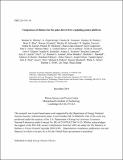| dc.contributor.author | Whitley, Heather D. | en_US |
| dc.contributor.author | Kemp, G. Elijah | en_US |
| dc.contributor.author | Yeamans, Charles B. | en_US |
| dc.contributor.author | Walters, Zachary B. | en_US |
| dc.contributor.author | Blue, Brent E. | en_US |
| dc.contributor.author | Garbett, Warren J. | en_US |
| dc.contributor.author | Schneider, Marilyn B. | en_US |
| dc.contributor.author | Craxton, R. Stephen | en_US |
| dc.contributor.author | Garcia, Emma M. | en_US |
| dc.contributor.author | McKenty, Patrick W. | en_US |
| dc.contributor.author | Gatu Johnson, Maria | en_US |
| dc.contributor.author | Caspersen, Kyle | en_US |
| dc.contributor.author | Castor, John I. | en_US |
| dc.contributor.author | Däne, Markus | en_US |
| dc.contributor.author | Ellison, C. Leland | en_US |
| dc.contributor.author | Gaffney, Jim A. | en_US |
| dc.contributor.author | Graziani, Frank R. | en_US |
| dc.contributor.author | Klepeis, John E. | en_US |
| dc.contributor.author | Kostinski, Natalie B. | en_US |
| dc.contributor.author | Kritcher, Andrea L. | en_US |
| dc.contributor.author | Lahmann, Brandon | en_US |
| dc.contributor.author | Lazicki, Amy E. | en_US |
| dc.contributor.author | Le, Hai P. | en_US |
| dc.contributor.author | London, Richard A. | en_US |
| dc.contributor.author | Maddox, Brian | en_US |
| dc.contributor.author | Marshall, Michelle C. | en_US |
| dc.contributor.author | Martin, Madison E. | en_US |
| dc.contributor.author | Militzer, Burkhard | en_US |
| dc.contributor.author | Nikroo, Abbas | en_US |
| dc.contributor.author | Nilsen, Joseph | en_US |
| dc.contributor.author | Ogitsu, Tadashi | en_US |
| dc.contributor.author | Pask, John E. | en_US |
| dc.contributor.author | Pino, Jesse E. | en_US |
| dc.contributor.author | Rubery, Michael S. | en_US |
| dc.contributor.author | Shepherd, Ronnie | en_US |
| dc.contributor.author | Sterne, Philip A. | en_US |
| dc.contributor.author | Swift, Damian C. | en_US |
| dc.contributor.author | Yang, Lin | en_US |
| dc.contributor.author | Zhang, Shuai | en_US |
| dc.date.accessioned | 2025-03-21T20:20:34Z | |
| dc.date.available | 2025-03-21T20:20:34Z | |
| dc.date.issued | 2019-12 | |
| dc.identifier | 19ja114 | |
| dc.identifier.uri | https://hdl.handle.net/1721.1/158695 | |
| dc.description | Submitted for publication in High Energy Density Physics | |
| dc.description.abstract | We examine the performance of pure boron, boron carbide, high density carbon, and boron nitride ablators in the polar direct drive exploding pusher (PDXP) platform. The platform uses the polar direct drive con guration at the National Ignition Facility to drive high ion temperatures in a room temperature capsule and has potential applications for plasma physics studies and as a neutron source. The higher tensile strength of these materials compared to plastic enables a thinner ablator to support higher gas pressures, which could help optimize its performance for plasma physics experiments, while ablators containing boron enable the possiblity of collecting addtional data to constrain models of the platform. Applying recently developed and experimentally validated equation of state models for the boron materials, we examine the performance of these materials as ablators in 2D simulations, with particular focus on changes to the ablator and gas areal density, as well as the predicted symmetry of the inherently 2D implosion. | |
| dc.publisher | Elsevier | en_US |
| dc.relation.isversionof | doi.org/10.1016/j.hedp.2021.100928 | |
| dc.source | Plasma Science and Fusion Center | en_US |
| dc.title | Comparison of ablators for the polar direct drive exploding pusher platform | en_US |
| dc.type | Article | en_US |
| dc.contributor.department | Massachusetts Institute of Technology. Plasma Science and Fusion Center | |
| dc.relation.journal | High Energy Density Physics | |
